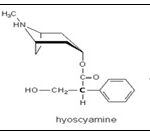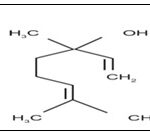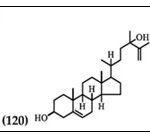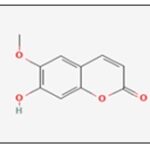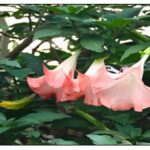A WILD TRADITIONAL MEDICINAL PLANT ANGEL’S TRUMPET (BRUGMANSIA SUAVELENS FAMILY- SOLANACEAE): AN OVERVIEW
HTML Full TextA WILD TRADITIONAL MEDICINAL PLANT ANGEL’S TRUMPET (BRUGMANSIA SUAVELENS FAMILY- SOLANACEAE): AN OVERVIEW
Alka Tailwal *, Arvind Negi and Vinita Chauhan
Department of Pharmacognosy, GRD (PG) IMT, Dehradun, Uttarakhand, India.
ABSTRACT: Brugmanisa suaveolens, also known as the angel's trumpet and a member of the Solanaceae family, is found throughout Asia, India, Europe, Australia, and North and South America. This study looks at current information on the distribution, phytochemistry, pharmacology, and toxicology of Brugmansia suaveolens (Solanaceae) utilizing the extracts or chemical compounds at this time, as found in various search engines. This plant has been used in traditional medicine throughout cultures as a muscle relaxant, nematicide, aphrodisiac, hallucinogen, and treatment for inflammation, rheumatism, asthma, and allergies. Hyoscyamine, a tropane alkaloid, is a key bioactive component of the plant with anticancer action. Additionally, hazardous consequences such as severe anticholinergic symptoms like delirium, hallucinations, and psychosis may be caused by this herb. Different chemical substances have been detected in the plant's flowers, fruits, stems, and roots, including alkaloids, volatile chemicals (mostly terpenes), coumarins, flavonoids, steroids, and hydrocarbons. Atropine and scopolamine are primarily responsible for the plant's toxicity. According to pharmacological research, an aqueous extract has an antinociceptive impact on mice. The ethanolic extract, on the other hand, exhibited nematocidal action in-vitro.
Keywords: Nematicide, Antinociceptive, Alkaloids, Hallucinatory
INTRODUCTION: The huge eudicot family Solanaceae, which has around 2,500 species and is found in both tropical and temperate climates, is primarily indigenous to Central and South America. Additionally, it contains significant plants grown worldwide for food, medicine, and ornamentation. The latter two categories also apply to the South American genus Brugmansia Pers., which has seven species found in Venezuela, Colombia, northern Chile, and southeast Brazil 1.
This herb has been used in traditional medicine throughout cultures as a nematicide, aphrodisiac, analgesic, muscle relaxant, sleep aid, and treatment for inflammation, rheumatism, and asthma 2. Different chemical components, including alkaloids, volatile chemicals (mostly terpenes), coumarins, flavonoids, steroids, and hydrocarbons, have been found and used in the plant's flowers, fruits, stems, and roots.
Depending on the biotic and abiotic factors that the plant is exposed to, the concentration of the various chemicals fluctuates. Both as a spontaneous species and as a decorative plant, Brugmansia suaveolens (Humb. and Bonpl. ex Willd.) Bercht. and J. Presl is widely distributed worldwide, mostly in regions with climates ranging from tropical and subtropical to temperate 3. It is a member of the Solanaceae family, and according to The Plant List, 12 species, including hybrids and a subspecies, are recognised in this genus (Brugmansia arborea, B. candida, B. cubensis, B. dolichocarpa, B. insignis, B. longifolia, B. pittieri, B. rubella, B. sanguinea, B. sanguineasubsp) 4.
Ethnobotany: Despite being primarily employed as a hallucinogen in shamanic ceremonies by various tribes in Latin America, including several ethnic groups from the Amazon of Peru and Ecuador, B. suaveolens is also utilized in traditional medicine. It is used externally by the Inga people of Colombia to fight off the evil spirits that cause insomnia 5. Due to their ease of growing and the creation of their distinctive floral smell at twilight, which reaches its highest peak at 21:00, many of these species are principally valued as ornamentals 6. However, the Spanish were the ones who initially employed these plants medicinally in colonial times, using them to cure rheumatism, infections, and asthma 7. For sores, to heal wounds without leaving scars, to treat pain generally, especially chest pain 8, to treat abscesses, dermatitis, and fungal infections of the skin 9, to treat snake bites, to relieve toothache, to treat inflammation from trauma, to reduce general body inflammation, to treat toothache, to treat diarrhoea, gonorrhoea, and to treat loss of appetite. Eye pain and coughing are treated with flower buds 10, 11.
Phytochemical Properties: This healing species has been the subject of chemical investigations since 1996. Identified as amines, carbohydrates, alkaloids, phenolic chemicals, flavonoids, steroids, terpenoids, tannins, anthraquinone glycosides, saponins, and triterpenes 12, 13, these investigations were the first qualitative on groupings of components. The ethanolic extract of the flowers was also used to quantify the alkaloids (5.903 _ 0.01333 mg/g), phenolic compounds (3.435 _ 0.0110 mg/g), and flavonoids (9.945 _ 0.0256 mg/g) 12. The concentrations of these substances can alter, much like the volatile chemical profiles of living flowers, which are constantly changing due to both internal (genetic) and environmental (light, temperature, and water stress) variables. Cut flowers experience a quicker degeneration and a loss of volatile compounds 14. Attacks by herbivores and diseases (viruses, bacteria, fungus, and nematodes) are other variables that have an impact on it. Drawings of the structures of organic chemical compounds were created using the Marvin programme 15.
Alkaloids: Tropane alkaloids contain cancer-preventing properties. Therefore, further research should be done in this area about this population. 59 alkaloids have been found in the mature flowers, as well as in the juvenile flowers and fruits, corolla, flowers, roots, and flower nectar, making it one of the most researched plants chemically 16, 17.
FIG. 1: PART USED: RIPE & IMMATURE FLOWER ROOT CULTIVATION, COROLLA ROOT CULTIVATION, COROLLA 18, 19
Volatile Compounds: In the flowers and leaves, 50 volatile compounds have been identified, most of which are found in the flowers.
FIG. 2: HEXANOL LINALOOL ALPHA-TERPINEOL PART USED: FLOWER 20, 21
Steroids: Three Steroids have been identified in the flowers and leaves.
FIG. 3: 20-HYDROXYECDYSONE (FLOWER) 120. PHYSALINDICANOL A (LEAVES) 121. PHYSALINDICANOL B (LEAVES) 20, 22
Hydrocarbons: Hydrocarbons the presence of four hydrocarbons in B. suaveolens has been identified only in the flowers.
FIG. 4: 1. PENTACOSANE (FLOWER) 2. HEPTACOSANE (FLOWER) 3. NONACOSANE (FLOWER) 4. HENTRIACONTANE (FLOWER) 23
Phenolic Compounds, Coumarin, and Flavonoids: A glycosylated phenolic compound, a coumarin, and seven flavonoids have been identified, in the flowers and leaves.
FIG. 5: ACANTHOSIDE B (FLOWER) SCOPOLETIN (FLOWER) KAEMPFEROL (FLOWER & LEAVES) 24, 25
Plant Profile 26, 27:
FIG. 6: BRUGMANSIA SUAVEOLENS
Common Name: Angel's tears and snowy angel's trumpet.
Botanical Name: Brugmansia suaveolens.
Divison: Mangnoliophyta- Flowering plants.
Class: Mangnoliopsida.
Order: Solanales
Kingdom: Plantae
Subkingdom: Tracheobionta
Superdivision: Spermatophyta
Tribe: Datureae
Family: Solanaceae
Genus: Brugmansia
Species: B. suaveolens
Flowering Time: October-February.
Ecological Note: Extremely rare from Mt. Abu.
Distribution: Australia, Brazil, California, Central America, Florida, Greece. India, Kenya, Mexico, Portugal and Sri Lanka.
Indian Distribution: Andhra Pradesh, Assam, Karnataka, Maharashtra, Nagaland, Tamil Nadu, Tripura, Uttarakhand and West Bengal.
Morphological Features: In terms of form and chemistry, the genus Brugmansia and the name Datura are closely related. The majority of the morphological traits are similar in both, and the main distinctions between them are found in the habit and fruit traits. Datura ceratocaula is a semi-aquatic hollow-stemmed prostrate creeping plant that is only found in Mexico and Central America. Due of its distinctive combination of traits, it is regarded as the connection between shrubby Brugmansia and herbaceous Datura 28, 29. The leaves are ovate-lanceolate, green, deciduous, alternating, petiolate (up to 12.2 cm long), simple, acute-acuminate at the tip, asymmetric, and cuneate at the base. The axillary, solitary flowers grow on a 3.3–4.7 cm long peduncle that is covered in multicellular appressed trichomes. The 5-lobed, gamosepalous calyx has a tube that is 6.0–6.8 cm long 30.
Pharmacological Activity & Toxicity: Many Latin American nations have reported using Brugmansia suaveolens in traditional medicine, but the earliest reports date back 22 years 31. Future research is still possible because the plant has received very few pharmacological studies.
Toxicity: The content of the alkaloids linked to the plant's toxicity might grow or decrease depending on a number of circumstances (climatic and seasonal). Its involvement in poisoning has been observed in numerous regions of the world, and other species, including B. candida, B. sanguinea, and B. candida, are regarded as poisonous in some countries, such as Mexico, especially their seeds 32. It is documented that an intake of 4 to 5 g of raw leaf, or just a seed, can cause a child to die. The signs and symptoms of Angel’s Trumpet poisoning are mydriasis, dry mouth, delirium, reddened skin, dry skin, agitation/aggressiveness, reduced bowel sounds, ileal paralysis, drowsiness, visual hallucinations, tachycardia, urinary retention, fever, increased systolic bloodpressure, a Glasgow Coma Scale (GCS) of <12, vertigo, decreased temperature and difficulty in breathing prior to coma 33. Unusual poisoning occurred in a five-year-old boy who consumed flowers; consequently, unilateral tonic pupils and Guillain-Barré syndrome were observed 34. Common causes for plant related poisoning include accidental ingestion, misuse as herbal products, suicidal attempts and deliberate abuse of hallucinogenic plant substances. Accidental poisoning with datura and Bs is by far the most common incidence in Asian countries with wrongful use of traditional medicines. Whereas in Central and North America, Bs toxicity is mostly due to abuse ingestion, especially among the younger 35.
Antigenotoxic Activity: The extract of the flowers of B. suaveolens through the micronucleus assay showed: Genotoxic activity at doses of 250, 500 and 1000 mg / kg and showed antigenotoxic activity at doses of 250 mg / kg. Further studies are needed with this plant to have a more complete assessment of the dangers that the plant can offer and its applicability in the treatment of diseases 33. In some studies that evaluated antigenotoxic potential, the results showed that smaller doses were able to inhibit the effect of the substances used for the positive control 36.
Cytotoxicity: Studies of the cytotoxic evaluation of the aqueous extract of B. suaveolens were carried out in the Brine-shrimp model (Artemia sp., Artemiidae) during 24 h, the concentrations of 1000, 500, 250, 125,62.5, 31.25, and 0 (_g/mL) were evaluated. An LC50 of 106 g/mL was obtained 37.
Antinociceptive: The aqueous extract of B. suaveolens flowers was administered at 100 and 300 mg/kgi doses.p. They significantly inhibited (p < 0.05) the induced contortions and increased the percentage of inhibition by acetic acid to 0.6% (3.0 _ 0.8 and 94.9%, and 0.6 _ 0.5 and 99%, respectively). Diclofenac 5 mg/kg i.p (43.4 _ 3.5 and 25.8%) was used as a positive control. An increase in the latency time was observed in the formalin test (20 _L of 2.5%); in the first phase (0–5 min), with a dose of 100 mg/kgm (15.6 _ 4.2 s and 63.3%) and 300 mg/kg (0.3 _ 0.3 s and 98.6%) and diclofenac (43.6 _ 7.0 s and 0%), and the second phase (20–25 min) with a dose of 100 mg/kg (7.5 _ 2.8 s and 82.2%) and 300 mg/kg(0.0 _ 0.0 s and 100%) and diclofenac (7.0 _ 2.8 s and 69.6%) in male Swiss albino mice. The hot plate and tail dip tests 38 also observed an increase in the latency time. In another study of the aqueous extract of flowers of B. suaveolens on the probable antinociceptive mechanism of the 300 mg/kg dose, a mechanism on benzodiazepine receptors was found. Flumazenil (5 mg/kg, i.p.) was used as an antagonist 39.
Nematicide: The ethanolic extract of flowers at 1000 mg/L concentration showed a 64% in-vitro nemato cidal activity against Meloidogyne incognita within 72 h. In another study of the ethanolic extract of aerial parts (flowers, flowers, and stems), a 100% larvicidal activity at a dilution of 12.5 mg against Ancylostoma spp was shown 40.
Antimicrobial: The antibacterial activity of the aqueous extract of B. suaveolens flowers against Bacillus thurigiensis was evaluated in one study and showed no activity 41.
Muscle Relaxer: Brugmansia suaveolens ethanol extract inhibits rabbit smooth muscle contractility at 100% at a 75.5 g/Ml 31 concentration.
CONCLUSION: This review details the distribution and ethnomedical, phytochemical, pharmacological, and toxicological uses of B. suaveolens worldwide. The scientific investigations that have been carried out to date are scarce; the analgesic, cytotoxic, nematicidal, and antimicrobial activity has been studied. However, regarding it’s chemistry, it is important to highlight that 125 compounds have been reported and identified, and a high percentage are not associated with pharmacological activity. Ethnomedicaluses reported worldwide include its uses to treat pain, insomnia, rheumatism, infections, asthma, inflammation, sores, wounds, abscesses, dermatitis, snakebites, loss of appetite, coughs, and an aphrodisiac. From this empirical and traditional knowledge in different countries, the scientific validation of this plant species emerges as a great area of opportunity, which provides an opportunity for interdisciplinary collaboration between different research groups.
ACKNOWLEDGEMENT: Nil
CONFLICT OF INTEREST: Nil
REFERENCES:
- Hay A: Brugmansiasuaveolens. The IUCN Red List of Threatened Species 2014; T51247699A58913403, http://www.iucnredlist.org/details/51247699/0 (accessed 15 March 2020).
- Hay A, Gottschalk M and Holguín A: Huanduj: Brugmansia. Florilegium, Glebe. Royal Botanic Gardens, Kew 2012; 424.
- The Plants List. Brugmansia suaveolens. 2020. Available online: http://www.theplantlist.org./tpl1.1/record/ kew-26840192020 (accessed on 18 August 2020).
- Chellemi DO, Webster CG, Baker CA, Annamalai M, Achor D and Adkins S: Widespread occurrence and low genetic diversity of Colombian datura virus in Brugmansia suggest an anthropogenic role in virus selection and spread. Plant Dis 2011; 95: 755–761.
- De Feo V: The ritual use of Brugmansia species in traditional Andean medicine in northern Peru. Econ Bot 2004; 58: 221–229.
- Laferriere JE: Medicinal plants of the Lowland Inga people of Colombia. Int J Pharmacogn 1994; 32: 90–94.
- Schultes ER and Plowman T: The ethnobotany of Brugmansia. J Ethnopharmacol 1979; 1: 147–164.
- Lalzarzovi ST and Lalramnghinglova H: Traditional use of medicinal plants found within Aizawl city in Mizoram, India. Pleione 2016; 10: 269–277.
- Batoro J and Siswanto D: Ethnomedicinal survey of plants used by local society in Poncokusumo district, Malang, East Java Province, Indonesia. Asian J Med Biol Res 2017; 3: 158–167.
- Encarnación-Dimayuga R, Altamirano L and Maki KA: Screening of medicinal plants from Baja California Sur (Mexico) by their e_ects on smooth muscle contractility. Pharm Biol 1998; 36: 124–130.
- Carlini EA and Maia LO: Plant and fungal hallucinogens as toxic and therapeutic agents. Toxinology 2015; 1–44.
- Freitas AVL, Trigo JR, Brown KS, Witte L, Hartmann T and Barata LES: Tropane and pyrrolizidine alkaloids in the ithomiines Placidula euryanassa and Miraleria cymothoe (Lepidoptera: Nymphalidae). Chemoecology 1996; 7: 61-67.
- Sakunthala P, Charles A, Kesavan D and Ramani VA: Phytochemical screening and adsorption studies of Brugmansia suaveolens. CSRL 2013; 29: 319–322.
- Nandakumar A, Vaganan MM, Sundararaju P and Udayakumar R: Phytochemical analysis and nematicidal activity of ethanolic leaf extracts of Datura metel, Datura innoxia and Brugmansia suaveolens against Meloidogyne incognita. Asian J Biol 2017; 2: 1–11.
- Marvin, “MarvinSketch 18.04”. 2018. Available online: http://www.chemaxon.com (accessed on 25 March 2020).
- Alam EA: In-vitro cultures for the production of some anticancer agents. Life Sci J 2013; 10: 297–310.
- Pinto CF, Salinas S, Flores-Prado L, Echeverría J and Niemeyer HM: Sequestration of tropane alkaloids from Brugmansia suaveolens (Solanaceae) by the treehopper Alchismegrossa (Hemiptera: Membracidae). Biochem. Syst Ecol 2016; 66: 161–165.
- Doncheva T, Berkov S and Philipov S: Comparative study of the alkaloids in tribe Datureae and their chemosystematic significance. BSE 2006; 34: 478–488.
- Zayed R and Wink M: Induction of tropane alkaloid formation in transformed root cultures of Brugmansia suaveolens (Solanaceae). Z. Nat C 2004; 59: 863–867.
- Anthony SJ, Zuchowski W and Setzer WN: Composition of the floral essential oil of Brugmansia suaveolens. Rec Nat Prod 2009; 3: 76.
- Stashenko EE and Martínez JR: Sampling flower scent for chromatographic analysis. J Sep Sci 2008; 31: 2022–2031.
- Sajeli Begum A, Sahai M, Fujimoto Y, Asai K, Schneider K, Nicholson G and Suessmuth R: A new kaempferol diglycoside from Datura suaveolens Humb. & Bonpl. ex. Willd. Nat Prod Res 2006; 20: 1231–1236.
- Mai NT: Investigation on chemical constituents of the Brugmansiasuaveolens flowers. J Multidiscip Eng Sci Technol 2019; 6: 10021–10024.
- Geller F, Murillo R, Steinhauser L, Heinzmann B, Albert K, Merfort I and Laufer S: Four new flavonol glycosides from the leaves of Brugmansia suaveolens. Molecules 2014; 19: 6727–6736.
- Mai NT: Investigation on chemical constituents of the Brugmansia suaveolens flowers. J Multidiscip Eng Sci Technol 2019; 6: 10021–10024.
- Bye R and Sosa V: Molecular phylogeny of the jimsonweed genus Datura (Solanaceae). Syst Bot 2013; 38: 818–829.
- Hunziker AT: Genera Solanacearum: The Genera Solanaceae. Illustrated, arranged According to a New 43. System. Gantner Ruggell Liechtenstein 2001.
- CABI (2020) Brugmansia suaveolens [original text by N. Pasiecznik]. Invasive Species Compendium. Wallingford, UK, CAB International, https://www.cabi.org/isc/datasheet/107903(accessed 15 March 2020)
- Freitas AVL, Trigo JR, Brown KS, Witte L, Hartmann T and Barata LES: Tropane and pyrrolizidine alkaloids in the ithomiines Placidula euryanassa and Miraleria cymothoe (Lepidoptera: Nymphalidae). Chemoecology 1996; 7: 61–67.
- Bemhardi JJ: Uber die Arten der Gattung Datura. Trommsdorf Neues J Pharmacie 1833; 26: 118-158.
- Encarnación-Dimayuga R, Altamirano L and Maki KA: Screening of medicinal plants from Baja California Sur (Mexico) by their effects on smooth muscle contractility. Pharm Biol 1998; 36: 124–130.
- Doan UVM, Wu L, Phua DH, Mendez Rojas B and Yang CC: Datura and Brugmansia plants related antimuscarinic toxicity: An analysis of poisoning cases reported to the Taiwan poison control center. Clin Toxi 2019; 57: 246–53.
- Isbister GK, Oakley PA, Dawson H and Whyte IM: Presumed Angel’s trumpet (Brugmansia) poisoning: Clinical effects and epidemiology. Emerg Med 2003; 15: 376–382.
- Monroy-Ortiz C and Monroy R: Las Plantas, Compañeras de Siempre: La Experienciaen Morelos, 1st ed.; UAEM, Centro de Investigaciones Biológicas de la Conabio Conanp: Cuernavaca, Morelos, Mexico 2006.
- Kerchner A and Farkas Á: Worldwide poisoning potential of Brugmansia and Datura. Forensic Toxi 2020; 38: 30–41.
- Genotoxic Santosi and Mateus S: Genotoxic and antigenotoxic activities of Brugmansia suaveolens extract in bone marrow of mice WJPPS 2020; 9(8): 60-67.
- Bussmann RW, Malca G, Glenn A, Sharon D, Nilsen B, Parris B, Dubose D, Ruiz D, Saleda J and Martinez M: A townesmith toxicity of medicinal plants used in traditional medicine in Northern Peru. J. Ethnopharmacol 2011; 137: 121–140.
- Parker A, Goulart Peraza G, Sena J, Sinnott Silva E, Flores Soares MC, Cezar Vaz MR, Badiale Furlong L and Muccillo-Baisch AL: Antinociceptive effects of the aqueous extract of Brugmansia suaveolens flowers in mice. Biol Res Nurs 2007; 8: 234–239.
- Muccillo-Baisch AL, Parker AG, Cardoso GP, Cezar-Vaz MR and Flores Soares MC: Evaluation of the analgesic effect of aqueous extract of Brugmansia suaveolens flower in mice: Possible mechanism involved. Biol Res Nurs 2010; 11: 345–350.
- Santos ID, Souza F, Akisue G, da Coelho SFA and Coelho MDG: Evaluation of ovicidal and larvicidal activity of ten plant extracts against Ancylostoma spp Rev Patol Trop 2013; 42: 209-216.
- Vilani A, Lozano ER, Potrich M, de Gouvea A, Martins Costa Maia F, Angeli Alves LF and Dall Agnol de Lima J: Activity of plant aqueous extracts on Bacillus thuringiensis and their interactions on Anticarsia gemmatalis (Lepidoptera: Erebinae). Semin. Ciências agrárias 2017; 38: 1051–1057.
How to cite this article:
Tailwal A, Negi A and Chauhan V: A wild traditional medicinal plant angel’s trumpet (Brugmansia suavelens family- Solanaceae): An Overview. Int J Pharmacognosy 2023; 10(7): 362-67. doi link: http://dx.doi.org/10.13040/IJPSR.0975-8232.IJP.10(7).362-67.
This Journal licensed under a Creative Commons Attribution-Non-commercial-Share Alike 3.0 Unported License.
Article Information
4
362-367
898 KB
965
English
IJP
Alka Tailwal *, Arvind Negi and Vinita Chauhan
Department of Pharmacognosy, GRD (PG) IMT, Dehradun, Uttarakhand, India.
alkatailwal99@gmail.com
12 July 2023
20 July 2023
26 July 2023
10.13040/IJPSR.0975-8232.IJP.10(7).362-67
31 July 2023




